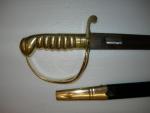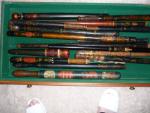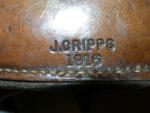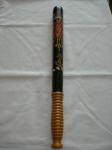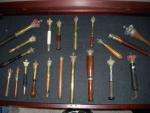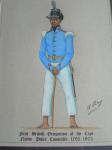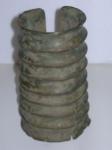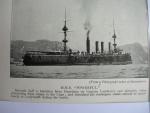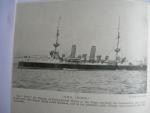-
Posts
13,225 -
Joined
-
Last visited
-
Days Won
22
Content Type
Profiles
Forums
Blogs
Gallery
Events
Store
Everything posted by Mervyn Mitton
-
I promised to send another police sword. This is the pattern for Thames River Police from 1798 and for the London Metropolitan Police from 1829. Unlike the Counties pattern, it is longer, not so curved and has bars on the guard. This is dated 1867 - when the Met. ordered new weapons for the Irish problem. (That should get some people going !!) Two following pictures. Mervyn
-
Three Scottish towns - or, cities had High Constables. Edinburgh, Leith and Perth. I am afraid this photo is a little cluttered - many of the pieces have been sold - however, the long staff in the middle - has a gold coloured centre and arms at each end, is for the Perth High Constables. Will try to get a photo for EHC - but, I have to depend on visitors to take photos now - and how do you explain which one of 400/500 you want - especially when you can't remember them clearly !!! Mervyn
-
Please post details and photos and hopefully, I will be able to help. Yes - there is a very good ref. book - I wrote it !!! 'The Policeman's Lot' Published by Quiller Press in 1985. There are copies in most libraries and under the title, a number of booksellers sell copies or, I probably have some spare ones in Bournemouth. I look forward to seeing the pictures. Mervyn
-
Thought these South African Railway badges might be of interest to the railway buffs - if there are in the GMIC? The cap badge with crown, probably dates from 30's or, 40's - the others are after 1964, when SA left the Commonwealth. The shoulder epaulettes are for a first class station, but not the very top such as Capetown or Jo'burg. I don't know much else about them - perhaps someone can give more history? Mervyn
-
While I'm on a roll (!) I thought I would include this very nice Edinburgh special Constables' truncheon. This would date from the 1850's/60's and they were in support of the regular police. Edinburgh has always had a long tradition of policing and in the 18th and 19th C. they had a volunteer body known as the Edinburgh's High Constables. They were really a group of middle class shop owners who had meetings and officers to run the association (I always think of them as mini-Masons!) however, they were a body of men who could be available at short notice for an emergency. They carried long staves - about 3 feet overall - and these were highly decorated at each end. I will try and get a picture sent from UK - unless any other member has one in their collection? I have never really eastablished why Edinburgh used the Naval fouled anchor - perhaps someone can help ? Mervyn
-
Tipstaffs are so uncommon, that many people do not realise the variety of shapes and sizes they in which they can occur. This display case used to be full- however, I have sold a lot in recent years. No.6 - on bottom - is a similar Glasgow Det. Office that I posted some time ago, but this one is a Malacca cane handle and is longer. The one on the far right has a silver plaque with the name and rank (Lt.) of an army officer. He may have been provost Corps,but ones named to the military are very rare. With most of the remaining collection, these are in the UK. Hope they are of some interest? Mervyn
-
A drawing in crayons of an early Cape Policeman - compare with Will Endley's photos ( see his posting on Cape Police) of a Cape Policeman in 1900. This drawing is by Andy May - one of S.A.'s top militaria artists - his work is in virtually every mess and collection in the Country. Should anyone want to commission a picture ( by overseas standards he is very reasonable ) I can put you in touch with him. Mervyn
-
I notice that this page is also for Zulu items - but, have found only a few. Known as an Ingxotha (pronounced In-gotcha) the arm band above is the highest award the Zulu King could give and was their equivalent of a VC and the Order of the Garter. About 8 - 9 inches , it is made from cast brass. Three kings used it - Dingaan; Panda and Cetshwayo. Cetchwayo was king during the Anglo-Zulu War of 1879 and this is of the pattern used during his reign. They were awarded to warriors who had greatly distinguished themselves in battle - and, also to very senior advisors to the king to show their rank. We don't know how many were actually given out, but only approx. 15 to 20 remain today. You had to be a braveman , even to receive the award ! The armband starts life as a sheet of cast brass, with the design in the casting - however, one side is smooth. The recipient has his arm (could be left or right) bound with wet hides and the flat - or, perhaps partly bent - red hot band is then beaten around , leaving the gap shown in the photograph. From then on it remains on the arm and they were usually buried with them - being brass it was a heavy item and must have been difficult to wear. Mervyn (I have a shield from Rorke's Drift and other items if anyone would like to see them?)
-
Dear Brian The button on the left is Queen Victoria (1837-1901) and, probably, the one on the right King Edward V11 (1901-1910). All early greatcoat buttons were made from horn and tunic buttons were metal , in most cases. When bakelite was introduced it was easier to use than horn. Are these greatcoat buttons ? The difference in Crowns is that until 1877 only the Crown of King Edward the Confessor ,1066 etc.! , existed. This had been remade but followed the original style. In 1877 Victoria was proclaimed Empress of India and the present Imperial State Crown was made. When a new monarch is proclaimed , they have the right to choose which Crown they will be shown wearing - also, the directiion - left or, right - that they will face on the coins,banknotes and postage stamps. Ed.V11, George V, Edward V111, George V1 all wear the Imperial State Crown - Queen Elizabeth chose King Edwards. (Ed.V111 was never crowned , so is always shown bareheaded - however, he had chosen his crown.) The easy way to tell them apart is the the Imperial has a domed appearance, whilst Edward's has an angular shape at the sides. Present pictures show it rounded off at the top of the arches - but, for Victoria and William 1V it is more cut-off. However, for the earlier Georgian crowns it is more domed. I am sure you will get more info.. Mervyn
-
I was browsing through an original copy of 'With the Flag to Pretoria' - this volume dealing with the first three monthe of the Boer War (1899-1902) and the defeat of Natal. I am quite sure many members will be familar with this set, however, sometimes it is interesting to see a subject brought out of context. These are a few of the naval pictures - if anyone is interested I will post a few more. I hope the captions can be read? Mervyn
-
Group of three - Boer War period (1899-1902) to the Cape Police - District 1. (See Will Endley's interesting post below, on the Cape Police). The Cape of Good Hope Gen. Service Medal, is on the left and has the Bechuanaland Bar. There were three possible bars - Bechuanaland (2483) ; Basutoland (1589); and Transkei (only 562) - however, they could be issued in combination and probably, in total there would have only been about 3500. The medal was issued by the Cape Govt., and only to local forces and vol. regts. (Medal Year Book). The CofGH is named - 34 Cpl.F Keitzmann C.Pol.. His QSA - 2 bars to same name, but Serjt. and Cape P. D1 ; whilst the KSA is same name and rank - C.P. Dist.1. Being a fairly rare medal this group is probably quite valuable. Mervyn



